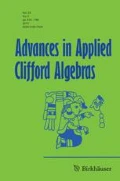Abstract
This work is intended as an attempt to extend the notion of bialgebra for Lie algebras to Leibniz algebras and also, the correspondence between the Leibniz bialgebras and its dual is investigated. Moreover, the coboundary Leibniz bialgebras, the classical r-matrices, and Yang–Baxter equations related to the Leibniz algebras are defined, and some examples are given. Finally, a method for the construction of a dynamical system on a Leibniz manifold via Leibniz bialgebra is presented.
Similar content being viewed by others
Notes
Note that, contrary to the Lie algebra the bracket of Leibniz algebra is not antisymmetric i.e. \([X,Y]\ne -[Y,X]\). This is the main difference between Leibniz algebra and Lie algebra.
Note that \(\mathfrak {g}\) acts on \(\mathfrak {g}\otimes \mathfrak {g}\) from left and right such that \(\mathfrak {g}\otimes \mathfrak {g}\) becomes a \(\mathfrak {g}\)-module.
Here we use the Einstein summation convention, i.e., we have the summation over the upper and lower indices.
In the following we use and generalize the similar method for Lie bialgebra as in [13] for the Leibniz bialgebra case.
Note that \([\xi ,\eta ]_{*}=\gamma ^{t}(\xi ,\eta )\), i.e., when \(\gamma =\delta ^{0}r\), we use \([\xi ,\eta ]^{r}\) instead of \([\xi ,\eta ]_{*}\).
Note that, our definitions for r-matrix and Yang–Baxter equations for the Leibniz algebra are different from the definition given in Ref. [9].
If \(B^{\mu \nu }\) be a combination of \(G^{\mu \nu }\) (the metric of the manifold M) and \(P^{\mu \nu }\) (the Poisson structure on M) then \(B^{\mu \nu }\) will be a metriplectic structure [10].
Note that for obtaining (6.10)–(6.13) one must use the relation \([X\otimes Y,Z\otimes W]=[X,Z]\otimes YW+XZ\otimes [Y,W]\,\forall X,Y,Z,W\in \mathfrak {g}\), but, this relation for the left (right) Leibniz algebra \(\mathfrak {g}\), is consistent with the left (right) fundamental identity if \(\mathrm {ad}^{(r)}\) and \(\mathrm {ad}^{(l)}\) be both derivation, i.e., if \(\mathfrak {g}\) is a left and right Leibniz algebra simultaneously. For this reason, relations (6.10)–(6.13) are only satisfied for especial Leibniz algebra, i.e., for (right and left) Leibniz algebras.
References
Albeverio, S., Ayupov, S.A., Omirov, B.A., et al.: Cartan subalgebras, weight spaces, and criterion of solvability of finite dimensional Leibniz algebras. Rev. Mat. Complut. 19(1), 183–195 (2006)
Ayupov, S.A., Omirov, B.: On Leibniz algebras. In: Algebra and Operator Theory, pp. 1–12. Springer (1998)
Ayupov, S.A., Omirov, B.A.: On some classes of nilpotent Leibniz algebras. Siber. Math. J. 42(1), 15–24 (2001)
Barnes, D.W.: On Levi’s theorem for Leibniz algebras. Bull. Aust. Math. Soc. 86(2), 184–185 (2012)
Barreiro, E., Benayadi, S.: A new approach to Leibniz bialgebras. Algebras Represent. Theory 19(1), 71–101 (2016)
Blokh, A.Y.: A generalization of the concept of a lie algebra. In: Doklady Akademii Nauk, vol. 165, pp. 471–473. Russian Academy of Sciences (1965)
Casas, J., Ladra, M., Omirov, B., Karimjanov, I.: Classification of solvable Leibniz algebras with null-filiform nilradical. Linear Multilinear Algebra 61(6), 758–774 (2013)
Drinfel’d, V.G.: Hamiltonian structures on lie groups, lie bialgebras and the geometric meaning of the classical Yang–Baxter equations. In: Yang–Baxter Equation in Integrable Systems, pp. 222–225. World Scientific (1990)
Felipe, R., López-Reyes, N., Ongay, F.: R-matrices for Leibniz algebras. Lett. Math. Phys. 63(2), 157–164 (2003)
Fish, D.: Metriplectic Systems. Portland State University (2005)
Grabowski, J., Urbański, P.: Algebroids-general differential calculi on vector bundles. J. Geom. Phys. 31(2–3), 111–141 (1999)
Kinyon, M.K.: Leibniz algebras, lie racks, and digroups. J. Lie Theory 17(1), 99–114 (2007)
Kosmann-Schwarzbach, Y.: Lie bialgebras, Poisson lie groups and dressing transformations. In: Integrability of Nonlinear Systems, pp. 104–170. Springer (1997)
Kotov, A., Strobl, T.: The embedding tensor, Leibniz–Loday algebras, and their higher gauge theories. Commun. Math. Phys. 376(1), 235–258 (2020)
Loday, J.L.: Une version non commutative des algebres de lie: les algebres de leibniz. Les rencontres physiciens-mathématiciens de Strasbourg-RCP25 44, 127–151 (1993)
Loday, J.L.: Cyclic Homology, vol. 301. Springer Science and Business Media (2013)
Loday, J.L., Pirashvili, T.: Universal enveloping algebras of Leibniz algebras and (co) homology. Math. Ann. 296(1), 139–158 (1993)
Mansuroğlu, N., Özkaya, M.: A note on the structure constants of leibniz algebras. In: AIP Conference Proceedings, vol. 2086, p. 030024. AIP Publishing LLC (2019)
Omirov, B.: Conjugacy of Cartan subalgebras of complex finite-dimensional Leibniz algebras. J. Algebra 302(2), 887–896 (2006)
Ongay, F.: \(\varphi \)-dialgebras and a class of matrix “coquecigrues.” Can. Math. Bull. 50(1), 126–137 (2007)
Ortega, J.P., Planas-Bielsa, V.: Dynamics on Leibniz manifolds. J. Geom. Phys. 52(1), 1–27 (2004)
Pirashvili, T.: On Leibniz homology. In: Annales de l’institut Fourier, vol. 44, pp. 401–411 (1994)
Sheng, Y., Liu, Z.: From Leibniz algebras to Lie 2-algebras. Algebras Represent. Theory 19(1), 1–5 (2016)
Sheng, Y., Tang, R.: Leibniz bialgebras, relative Rota–Baxter operators and the classical Leibniz Yang–Baxter equation. arXiv preprint arXiv:1902.03033v2 (2020)
Uchino, K.: Formal symplectic geometry for Leibniz algebras. arXiv preprint arXiv:1402.5615 (2014)
Acknowledgements
We would like to express our deepest gratitude to M. Akbari-Moghanjoughi for carefully reading the manuscript and his useful comments. This research was supported by Azarbaijan Shahid Madani University (Research Fund No. 27.d.1518).
Author information
Authors and Affiliations
Corresponding author
Additional information
Communicated by Michaela Vancliff.
Publisher's Note
Springer Nature remains neutral with regard to jurisdictional claims in published maps and institutional affiliations.
Rights and permissions
About this article
Cite this article
Rezaei-Aghdam, A., Sedghi-Ghadim, L. & Haghighatdoost, G. Leibniz Bialgebras, Classical Yang–Baxter Equations and Dynamical Systems. Adv. Appl. Clifford Algebras 31, 77 (2021). https://doi.org/10.1007/s00006-021-01177-w
Received:
Accepted:
Published:
DOI: https://doi.org/10.1007/s00006-021-01177-w



